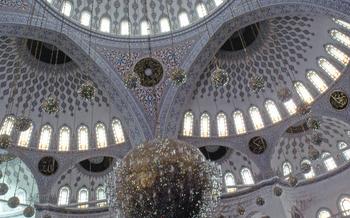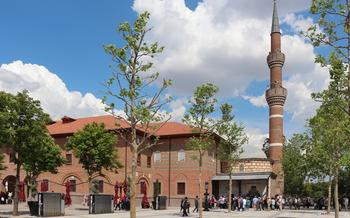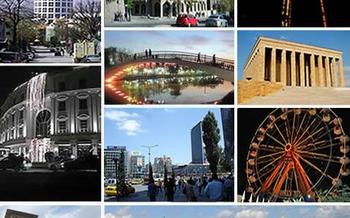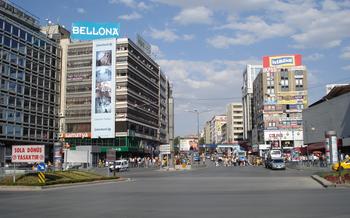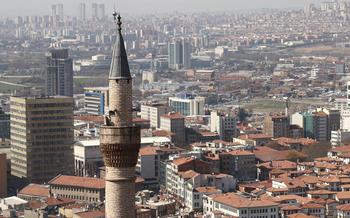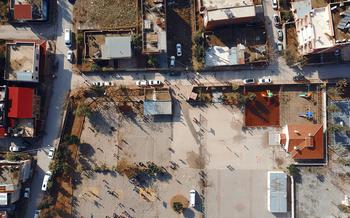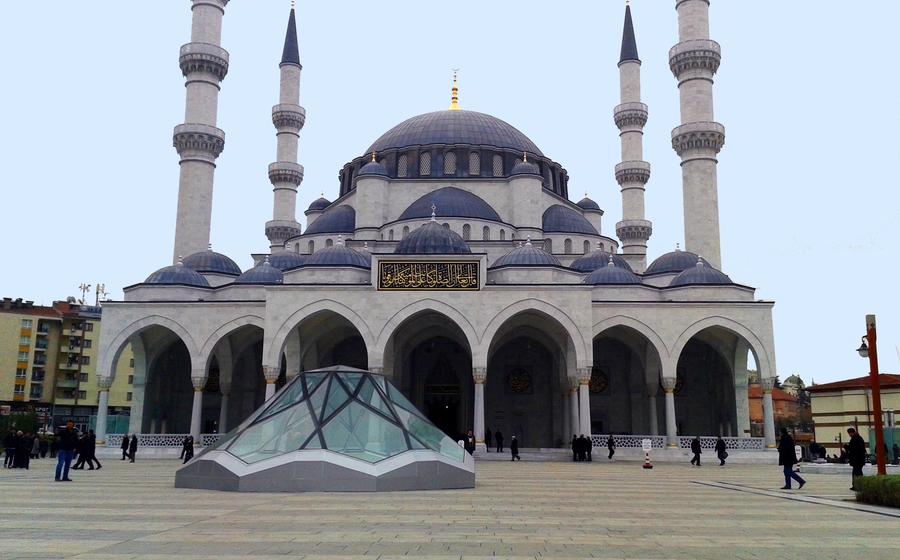
Melike Hatun Mosque
- Historical Significance
- Architectural Marvel
- Religious Significance
- Interior Beauty
- Visiting Hours:
- Location and Transportation:
- Dress Code and Etiquette
- Guided Tours
- Photography and Videography
- Accessibility
- Local Customs and Traditions
- Nearby Attractions
- Insider Tip:
Historical Significance
The Melike Hatun Mosque stands as a testament to the rich history and cultural heritage of Ankara. Constructed during the reign of the Seljuk dynasty in the 13th century, it played a pivotal role in the city's development as a prominent center of Islamic civilization. The mosque's unique architectural style, blending Seljuk and Ottoman influences, reflects the diverse cultural influences that shaped Ankara's history. As a symbol of Islamic heritage in Turkey, the Melike Hatun Mosque continues to attract visitors from around the world, offering a glimpse into the city's rich past and its enduring spiritual traditions.
Architectural Marvel
The Melike Hatun Mosque stands as a testament to the architectural prowess of the Seljuk dynasty. Its striking stonework and intricate carvings showcase the artistry and craftsmanship of its builders. The mosque's design seamlessly blends Seljuk and Ottoman architectural styles, creating a unique and harmonious structure.
The mosque's exterior is adorned with intricate geometric patterns, floral motifs, and Quranic inscriptions. The main entrance, framed by a pointed arch, features a mesmerizing display of colorful tiles and calligraphy. The slender minaret, rising high above the mosque, is a prominent landmark in Ankara's skyline.
Inside the mosque, visitors are greeted by a spacious prayer hall supported by elegant columns and arches. The mihrab, the niche indicating the direction of Mecca, is intricately carved with verses from the Quran and adorned with colorful tiles. The minbar, the pulpit from which the imam delivers sermons, is a masterpiece of craftsmanship, featuring intricate woodwork and inlaid mother-of-pearl.
The mosque's interior is bathed in a soft, ethereal light that filters through the stained-glass windows, creating a serene and contemplative atmosphere. The overall design of the Melike Hatun Mosque reflects the artistic and cultural achievements of its time, making it a must-see attraction for anyone interested in Islamic architecture and history.
Religious Significance
The Melike Hatun Mosque holds immense religious significance as a vibrant center of worship for Muslims in Ankara. Its strategic location within the city's historic center, adjacent to the ancient Ankara Castle, underscores its importance as a spiritual landmark. The mosque serves as a place of solace and communion for the Muslim community, where they gather for daily prayers, congregational gatherings, and religious celebrations.
During the holy month of Ramadan, the mosque transforms into a hub of spiritual devotion, with extended prayer sessions, Taraweeh prayers, and special sermons. The mosque's capacious prayer hall accommodates thousands of worshippers, creating a profound sense of unity and brotherhood. The mosque's serene ambiance and intricate Islamic ornamentation foster a deep sense of spirituality and connection with the divine, making it a cherished destination for religious pilgrims and devout Muslims.
Interior Beauty
The Melike Hatun Mosque's interior is a masterpiece of Islamic art and architecture, captivating visitors with its intricate details and vibrant colors. The walls and ceiling are adorned with colorful tiles, each tile meticulously hand-painted with geometric patterns, floral motifs, and verses from the Quran. The tiles create a mesmerizing kaleidoscope effect, transforming the mosque's interior into a symphony of light and color.
The mosque's mihrab, the niche indicating the direction of Mecca, is a particularly stunning feature. It is intricately carved from marble and adorned with gold leaf, creating a focal point that draws the eye and inspires awe. The minbar, the pulpit from which the imam delivers sermons, is equally impressive, showcasing fine craftsmanship and attention to detail.
The calligraphy throughout the mosque is another highlight, with verses from the Quran and the names of Allah beautifully inscribed in elegant Arabic script. The calligraphy adds to the mosque's sacred atmosphere and reminds visitors of the spiritual significance of this place of worship.
The overall effect of the mosque's interior is one of grandeur and splendor. The combination of colorful tiles, intricate carvings, and elegant calligraphy creates a sense of awe and tranquility, inviting visitors to pause and reflect on the beauty of Islamic art and architecture.
Visiting Hours:
The Melike Hatun Mosque is open to visitors from sunrise to sunset throughout the week, except during prayer times. Prayer times vary depending on the day and season, but generally occur at dawn, noon, afternoon, sunset, and night. It is advisable to check the mosque's official website or inquire locally for the exact prayer times to avoid any inconvenience.
While the mosque welcomes visitors of all faiths and backgrounds, it is important to be respectful of the religious customs and practices observed within the mosque. Visitors are encouraged to dress modestly and maintain a respectful demeanor while inside the prayer hall. Photography and videography are permitted within the mosque, but it is essential to be mindful of other visitors and avoid disturbing them during prayer or meditation.
To fully appreciate the mosque's beauty and significance, consider visiting during the early morning or late afternoon when the light is most flattering and the crowds are smaller. Combining a visit to the mosque with other nearby attractions, such as the Ankara Castle or the Museum of Anatolian Civilizations, can make for a comprehensive and enriching day of exploration in Ankara.
Location and Transportation:
The Melike Hatun Mosque is situated in the heart of Ankara, on Hacettepe Caddesi in the Ulus district. This vibrant neighborhood is home to several historical and cultural landmarks, making it an ideal starting point for exploring the city's rich heritage. To reach the mosque, visitors can conveniently use Ankara's public transportation system. The Ulus Metro Station, located just a short walk from the mosque, provides easy access from various parts of the city. Additionally, several bus lines stop nearby, offering a budget-friendly alternative. For those arriving by car, limited parking options are available in the surrounding streets. Visitors can also take advantage of nearby landmarks such as the Ankara Castle or the Ethnography Museum as reference points when navigating to the mosque.
Dress Code and Etiquette
When visiting the Melike Hatun Mosque, it is crucial to show respect for local customs and dress modestly. Men should avoid wearing shorts or tank tops, and women should cover their heads, shoulders, and knees. It is also important to remove your shoes before entering the prayer hall and to maintain silence and avoid disturbing others. Remember, the mosque is a place of worship, and respectful behavior is essential.
Guided Tours
Enhancing Your Experience with a Guided Tour
For a deeper dive into the history, architecture, and significance of the Melike Hatun Mosque, consider joining a guided tour. Led by knowledgeable experts, these tours offer insights and anecdotes that bring the mosque's past to life. Guides can point out hidden details, explain the symbolism behind the mosque's design, and answer your questions.
Booking a guided tour is easy and convenient. Most tour operators offer online reservations, allowing you to secure your spot in advance. Prices vary depending on the tour length, group size, and any additional services included.
If you prefer a more independent experience, audio guides are available for rent at the mosque. These self-guided tours provide recorded commentary that you can listen to at your own pace, offering flexibility and the freedom to explore at your leisure.
Whether you opt for a guided tour or an audio guide, learning about the Melike Hatun Mosque's rich history and cultural significance will enhance your visit, leaving you with a deeper appreciation for this architectural masterpiece.
Photography and Videography
The Melike Hatun Mosque welcomes visitors to capture the beauty of its architecture and interiors through photography and videography. However, it is essential to respect the sanctity of the mosque and adhere to the following guidelines:
-
Photography and videography are permitted for personal use only. Commercial photography or filming requires prior permission from the mosque authorities.
-
Photography and videography are not allowed during prayer times. Visitors should avoid disturbing worshippers during their prayers.
-
Using flash photography or video lights is not permitted inside the mosque. These lights can damage the mosque's delicate interior and disturb other visitors.
-
Visitors should be mindful of the privacy of other visitors and avoid taking photos or videos that may capture them without their consent.
-
The mosque's courtyard and exterior are great spots for capturing stunning photographs. Visitors can take panoramic shots of the mosque's facade and its surrounding gardens.
-
To avoid crowds, it is best to visit the mosque early in the morning or late in the afternoon. During these times, visitors can enjoy a more peaceful and intimate experience and capture beautiful photos without distractions.
Accessibility
The Melike Hatun Mosque is committed to ensuring that all visitors, regardless of their abilities, can enjoy its beauty and significance. The mosque is wheelchair accessible, with ramps leading to the entrance and prayer hall. There are also designated spaces within the mosque for visitors with disabilities. Additionally, the mosque offers guided tours in Turkish sign language for visitors who are deaf or hard of hearing. These tours must be booked in advance. For visitors who are blind or visually impaired, audio guides are available, providing detailed descriptions of the mosque's history, architecture, and interior design. These audio guides can be rented at the mosque's information desk. The mosque staff is always happy to assist visitors with disabilities, ensuring that everyone has a positive and memorable experience.
Local Customs and Traditions
When visiting the Melike Hatun Mosque, it is crucial to be mindful of local customs and traditions to ensure a respectful and positive experience. Visitors should dress modestly, avoiding revealing or tight-fitting clothing. Upon entering the mosque, it is customary to remove one's shoes and place them neatly on the designated shelves. Inside the prayer hall, maintaining silence and avoiding disturbing others is essential. Visitors should refrain from talking loudly or engaging in distracting behavior. It is considered respectful to ask permission before taking photographs or videos, especially if people are praying. By observing these customs and traditions, visitors can demonstrate respect for the mosque's sacredness and contribute to a harmonious and welcoming atmosphere.
Nearby Attractions
After exploring the Melike Hatun Mosque, visitors can venture into the vibrant city of Ankara and discover a wealth of nearby attractions. Within walking distance, the Ankara Castle stands as a testament to the city's ancient past, offering panoramic views from its ramparts. The Museum of Anatolian Civilizations, just a short stroll away, houses an impressive collection of artifacts from Turkey's rich history, including the renowned Hittite sculptures.
For those seeking a modern cultural experience, the CerModern art gallery showcases contemporary Turkish art, while the nearby State Opera and Ballet House offers a diverse program of performances. Nature enthusiasts can escape the city buzz at the Gençlik Park, a vast urban park with serene gardens, a lake, and a zoo.
To delve deeper into Ankara's culinary scene, visitors can explore the surrounding streets and indulge in traditional Turkish cuisine at local restaurants. The Kızılay district, known for its lively atmosphere, offers a range of dining options from traditional kebab houses to international cuisine.
Insider Tip:
For a truly unique experience, visit the Melike Hatun Mosque during the early morning hours before the crowds arrive. As the sun rises, casting a warm glow over the mosque's exterior, you'll have the chance to appreciate its beauty in tranquility. Take advantage of this serene atmosphere to capture stunning photographs without distractions. Remember to be respectful of other visitors who may be praying or meditating at this peaceful time of day.
